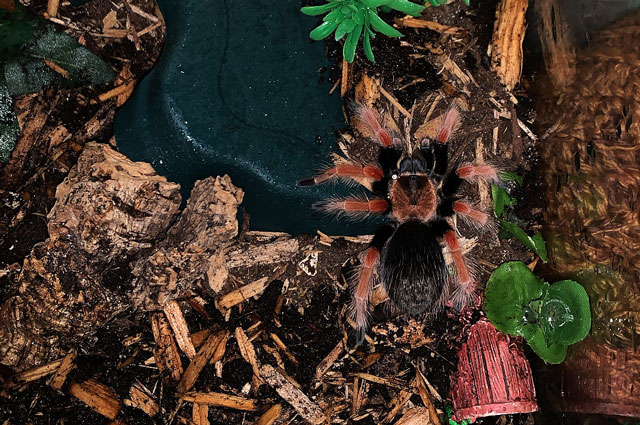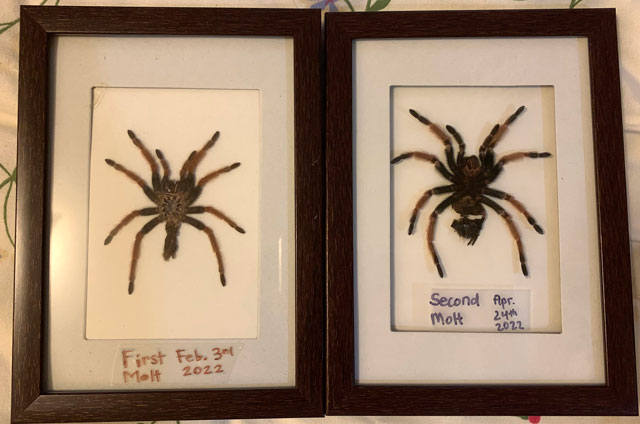Very Hairy Palm-Sized Pets

Aragog, a Mexican Red Knee Tarantula
By Valeria Martinez
Have you ever encountered someone so strange and peculiar that you’re intrigued by everything they do?
Some of the best moments in our lives can come from such unexpected friendships, like the one I have with Aragog, my pet tarantula.
I’m sure the first thing that popped into your head was, “A tarantula? Aren’t they poisonous and deadly?” Most of the “dangers” or stereotypes of tarantulas are due to their portrayal in the media. Tarantulas are gentle creatures and if they were to bite you, the venom, not poison, would be similar to a bee sting.
You will know when not to disturb tarantulas because, when threatened, they lift their front legs to look more intimidating. If you don’t heed that first warning, they brush the hairs off their abdomen with their back legs which can latch onto skin with tiny barbs and irritate you. If this happens, make sure to wash the area affected.
This might seem like a problem, but it rarely happens to tarantula caretakers. In the months I’ve had Aragog, it has only ejected urticating (barbed irritant) hairs when I first put it in its new enclosure. As time passes, you tend to get used to their behavior and learn when to back off and leave them alone.
I often find myself just watching Aragog crawl around its enclosure, wondering what it’ll do next. The majority of the time, it just stays in one place. Whenever I catch it moving and stop to look at it, it stops crawling, as if it can tell I’m staring at it. So I try to hide but it doesn’t move again until I’m completely gone.
I’m still getting used to taking care of Aragog. I knew it was a Mexican Red Knee Tarantula with the scientific name Brachypelma hamorii. The good thing about owning a tarantula is that the care-taking community is very helpful. There are a lot of resources for new owners.
Molting is a crucial step for tarantulas. They create a bed of webbing and lay on their backs, allowing the web to stick onto the old skin so they can wiggle out of it. It can take between 15 minutes to a whole day for the tarantula to finish molting. My father sent me a picture of Aragog on its back when I was going home from school, and mentioned that it wasn’t moving. My family got confused and thought it had died which set me off into a googling frenzy because I had no clue what was happening. Some of the websites I looked into even mentioned that new owners shouldn’t panic because it’s completely normal for them to do this. After settling down, I realized I would need to do a lot more research on this new friend of mine.

Aragog’s molts, February 3 and April 2022.
Depending on when you get a tarantula, if it’s a spiderling or a juvenile, it might be hard to determine its gender. It gets easier to know the gender when they’re fully in their adult stage. Males can live up to 10-14 years while females live 15-30 years. I don’t know the exact gender of Aragog because it is still too young to tell but I know as time passes, I’ll be able to figure that out. There are ways where you can find out the gender in their molts, but they have to be fresh, and his first molt was already two months old.
As for feeding, this is where it gets interesting. Tarantulas usually eat once or twice a week, sometimes even once or twice a month. Depending on the age and size, you might have to give them different foods. I feed Aragog Dubia roaches and they’re very different from the roaches we’re familiar with. Dubia roaches are more nutritious for tarantulas than crickets. Most owners feed them crickets because it’s a cheaper food option but Dubia roaches can give the tarantulas a more filling meal. Tarantulas also need water and it’s recommended to place a small, shallow water bowl that can be refilled or rinsed once a week.
Tarantulas are pretty low maintenance compared to cats or dogs and they’re a great pet for anyone. There are at least 850 different species of tarantulas, with some being terrestrial, ground-dwelling, or arboreal, or tree-dwelling. They’re all beautiful; some even come in very cool colors like the Cyriopagopus lividus, the cobalt blue tarantula, or the Avicularia avicularia, the pink-toe tarantula.
Saved under Featured Slide, News
